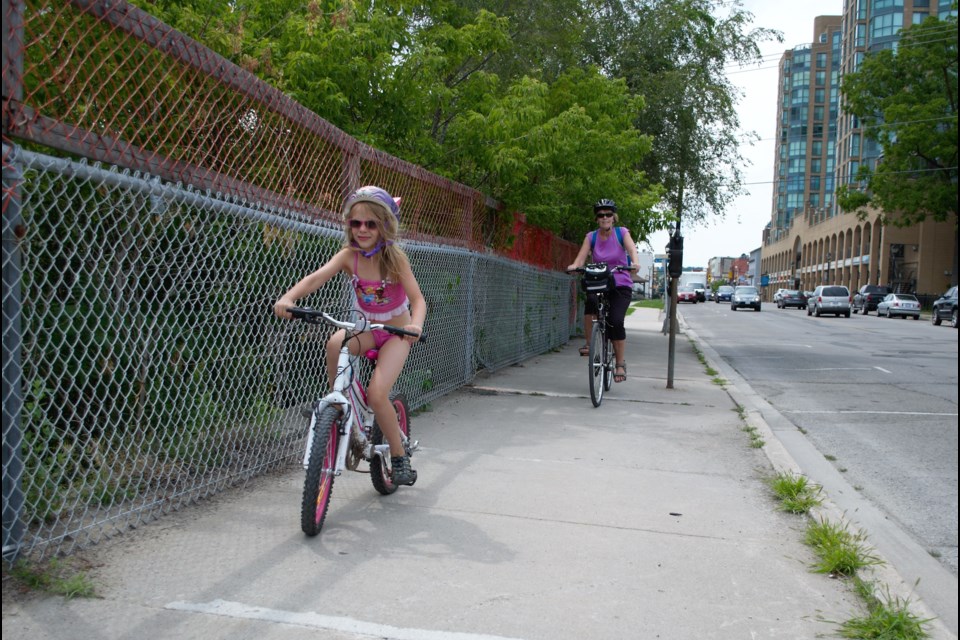While the sun is shining and the weather is beautiful, you might be tempted to dust off your bicycle and take it for a spin.
While cycling is proven to be excellent for your health, the Simcoe Muskoka District Health Unit wants residents to stay safe this season.
“It’s something I’ve always enjoyed for recreation and transportation,” said Simcoe Muskoka Medical Officer of Health Dr. Charles Gardner. “I believe in it from the point of climate change, environmental protection, physical activity and healthy living. It’s something I insist on it. I would do it through the winter if it were accommodated here.”
Gardner holds cycling as a topic that is near and dear to his heart as he is a life-long cyclist. He sees the changes that the city has made to make Barrie more cycling-friendly, but still sees potential for improvement.
“I think Barrie still has a ways to go,” he said.
Gardner points toward mode share, the percentage of people who choose to walk, cycle or drive. According to Gardner, Barrie sits at about 1% cycling mode share.
“Here in North America we’re very behind, and Barrie is typical of a city of its size,” he said. “That’s a direct reflection of how safe and inviting the environment is for cycling. The environments (here) have been created, overwhelmingly, for driving your car.”
While Gardner acknowledges that the city has created bike lanes in many areas of town, there are many areas where they don’t meet up.
“To really get people (cycling), you have to have a network that is complete throughout the city,” he said.
Some suggestions Gardner makes for improving safety for cyclists is adding barriers to separate bicycle lanes from traffic lanes, cyclists being more careful in planning and selecting their routes to avoid highly trafficked areas, and being aware of the more risky locations in town to cycle.
“We have two perspectives. There’s what you can do as the individual dealing with the environment you’re in, but we’re also active in changing the environment, because the environment drives behaviour,” he said. “If you set up the environment right, you can get most people to cycle for most of their needs for most of the year, which has been done in many European countries and cities.”
“To do that, you need political commitment, and you need plans fulfilled and made.”
Gardner points out that in Barrie, there is a lot of cycling infrastructure along the waterfront.
“There are bicycle lanes there that are separated, which is terrific,” he said. “Take advantage of what is there.”
In Barrie, Gardner says cyclists are allowed to ride on the sidewalk if the roadways are unsafe, although with a warning.
“You must be very cautious about being a hazard yourself to pedestrians,” he said.
Gardner is hoping drivers will also be accommodating and respectful of the new influx of cyclists on the road the warm weather brings.
“We have every right to be on the road under the law as much as they do,” said Gardner, adding that drivers are required by law to leave a one-metre distance between them and cyclists.
Peter Armstrong, owner of Born To Ride Bicycle, a cycling tourism operator in Barrie, sees the area as being decent for cycling.
“Overall, I find Simcoe County, Barrie included, is a cycle-friendly environment,” said Armstrong. “They take cycling a lot more seriously here, and drivers respect cyclists far more in this region then most.”
Armstrong points to efforts that can be made on the part of both cyclists and drivers to make the road safer for everyone.
“It's a team effort of the drivers and cyclists’ level of awareness and responsibility, not just one over the other pointing fingers,” he said. “Communication and eye contact is very critical. Every time a cyclist is about to make a move, just like a motorist, they both should be looking over their shoulder.”
Recently, the City of Barrie has undertaken many programs to encourage safer cycling for residents through infrastructure.
After securing the Commuter Cycling Grant from the province in December 2017, the city was able to add additional projects that were not previously in the budget according to Emma Sharpe, communications advisor for the city.
The first project is resurfacing the multi-use trail on Mapleview Drive West between Highway 27 and Essa Road. Construction is happening on that project in 2018.
The second project is creating a multi-use trail on Hurst Drive between Brennan Road and Minet’s Point to help complete a cycling network from that section of the city to the downtown core. The design phase for that program is happening in 2018, with construction expected to start in 2019.
Applications for the city’s Active Transportation Barrie Award are also now available on the city’s website. The city will be accepting applications until Sept. 28.
For more information, email [email protected].
Tips from the health unit
The Simcoe Muskoka District Health Unit offers more tips for cycling safety on their website.
- Cyclists are advised to obey all traffic laws, signs, and signals, always ride on the right in the same direction as traffic and ride in single file, except when passing
- Wear a helmet
- Be aware of the weather
- Follow the traffic rules and look in all directions before entering into a new space.
- Don’t assume traffic can see you
- Wear fluorescent and bright clothing, and reflectors
- Hand signals to communicate turns and stops to other road users is encouraged
For more safety tips from the health unit, click here.



